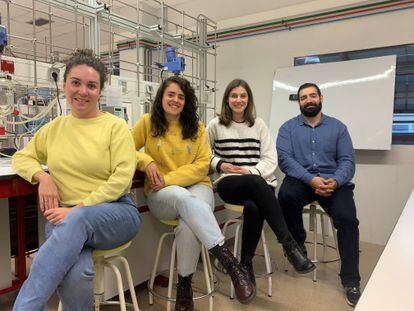Microplastic pollution has become a pressing concern for the health of the planet and people. These tiny pieces of plastic, less than five millimeters in size, multiply in oceans, seas and rivers, posing a silent but devastating threat to aquatic ecosystems and ultimately the global food chain. As a result, it has become imperative to look for innovative solutions to remove these contaminants.
The European Commission has announced the adoption of measures to control the intentional addition of granular aggregates used in artificial sports surfaces or products such as exfoliants in cosmetics. The aim is to avoid the release of half a million tonnes.

Adapting the technique to a 100,000 liter per hour plant would cost between 200,000 and 250,000 euros.
“The CSIC study found that the amount of plastic we consume is five grams per week, which is equivalent to a credit card. Although a part of it leaves our body, there is also a part that stays with us. In fact, there is research that has found microplastics in the placenta or in the blood,” says Captoplast director Rahul Barra.
With the aim of combating this threat, the company was born, a spin-off from the Autonomous University of Madrid, which has developed a technology with an efficiency of more than 90% that detects, measures and analyzes microplastics in aqueous media. , captures them and reuses them if desired. „The capture technology goes into a container. Water goes in and out, but we retain the microplastics using an aqueous consumable that traps them in this container. We capture them and remove them from the water so that the consumable can be reused and the microplastics can be used for any other use,” explains Parra.
Its technology is mainly focused on industrial and urban sewage treatment plants, as they are the main source of discharge of these harmful pollutants into the river and sea, he points out. Although the cost varies depending on the size of the facilities, a 100,000 liter per hour plant will cost between 200,000 and 250,000 euros to operate. Last year they closed with a turnover of around 50,000 euros and this year they hope to approach 400,000. Its projections are to cross two million by 2024.
Articles
Currently, they are conducting trials in several pilot plants to further improve their technology. For this reason, they are making one of 5,000 liters per hour to continue this pilot. They have tested their device in more than two institutions, both urban and industrial wastewater plants. Its goal is to start its implementation in a real environment with customers next year.
With its innovative removal technology, the Captoplast team has gone a step further and given companies the opportunity to do the work themselves to quantify how many contaminants are in their water. “We have developed a lab tool called Captolab that does everything automatically. The client simply adds a water sample to the device and, following the steps indicated on the screen, determines the number of milligrams per liter of microplastics. It doesn’t require specific requirements or electricity,” says Barra.
The 'spin-off’ carries out tests in several factories. It is expected to come into effect in 2024.
In this case, the company has already started marketing this „portable laboratory” for 62,400 euros. More optimally priced compared to other lab equipment, it is not only more complicated to use, but also less accurate and requires more critical technical skills, he assures. Captoplastic is already working on new ways of dealing with nanoplastics and helminth eggs, a contaminant that mainly occurs in reclaimed water.
Follow all the information Five days Inside Facebook, Twitter Y LinkedinOr nuestra newsletter Five day program
